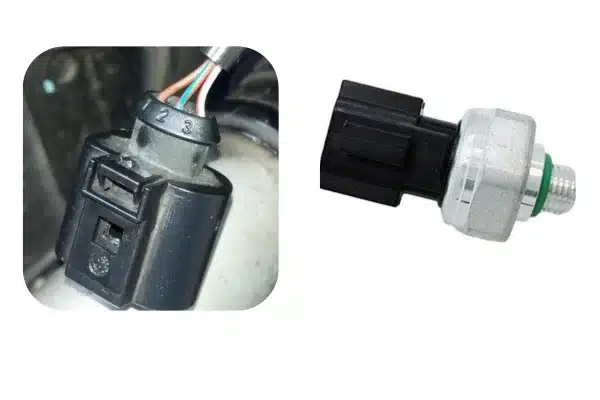Testing a low-pressure switch on an AC system is crucial for ensuring the safety of your unit and avoiding costly repairs down the line. This switch prevents an AC system from overworking and burning out due to excessive pressure from the refrigerant.
To test the switch, a multimeter will be needed. This blog post will provide step-by-step instructions on how to test ac pressure switch with a multimeter. But first, you need to understand how an AC pressure switch work and its types also.
What is the purpose of the Low-Pressure Switch?
This switch is a safety feature that will shut off the compressor if the refrigerant pressure drops below a certain level. It prevents damage to the AC system and allows the system to start up again when the pressure is back in the normal range.
High-Pressure vs. Low-Pressure Switches:
These two switches work together to protect your system. The high-pressure switch activates when the pressure is too high, and the low-pressure switch activates when the pressure is too low.
There are pros and cons to both high-pressure and low-pressure switches. High-pressure switches are more durable and can withstand higher pressures but are also more expensive.
Low-pressure switches are less expensive, but they may need to be more durable and able to handle as high of a force. It depends on what you need the switch for and what environment it will use.
How to Test Low-Pressure Switch on AC?
Following are the steps you need to follow while testing.
Get the Right Assembling the Tools:
Before starting the testing process, you must assemble the right tools. You will need a 5/16″ nut driver, a 1/4″ nut driver, a screwdriver, and a multimeter. The low-pressure switch ensures the AC system does not overwork and burn out. It turns off the compressor if the pressure gets too low or too high. Testing it with the multimeter will help keep your AC working properly.
The Low-Pressure Switch on your AC Unit:
Locate the low-pressure switch on your AC unit, which is usually located near the compressor. Once you have identified it, you can begin testing.
Using the Multimeter:
Set the multimeter to the ohm setting and attach one of the leads to a terminal on the switch. Then, attach the other lead to the ground (usually labeled ‘GND’). You should get a reading of around 0.
The ohm setting on a multimeter is essential in diagnosing low-pressure switches. The principle behind the ohm setting involves measuring the resistance in an electrical circuit. The ohm setting is used to determine if there is a shortage in the system, which could indicate potential problems with the low-pressure switch.
Checking the Continuity:
Once you have taken the initial ohm reading, you can check the continuity of the switch. To do this, attach one of the multimeter leads to a terminal on the button and then touch the other lead to the ground. If it reads 0 ohms, the switch is working correctly, and there is no shortage in the system.
How to test low pressure switch & test ac high pressure switch?

Testing AC Low Pressure Switch:
- Turn off the vehicle’s engine and let it sit for a few minutes to allow the pressure in the AC system to equalize.
- Locate the low-pressure switch on the AC system. It is usually situated on the low-pressure line or the accumulator.
- Disconnect the electrical connector from the low-pressure switch.
- Using a multimeter set to resistance (ohms) mode, probe the two terminals of the switch.
- A functional switch should display low resistance (close to zero ohms) when the AC system is pressurized. On the other hand, an open circuit or high resistance reading indicates a faulty switch.
- If the low-pressure switch fails the resistance test, it may need replacement to ensure the proper functioning of the AC system.
Testing AC High-Pressure Switch:
- As a safety precaution, turn off the vehicle’s engine and let it sit for a few minutes to allow the pressure in the AC system to equalize.
- Locate the high-pressure switch on the AC system. It is generally located on the high-pressure line or the compressor.
- Disconnect the electrical connector from the high-pressure switch.
- Utilize a multimeter set to resistance (ohms) mode to test the switch.
- Similar to the low-pressure switch, a properly functioning high-pressure switch should display low resistance (close to zero ohms) when the AC system is pressurized. Conversely, a high resistance reading or an open circuit indicates a malfunctioning switch.
- If the high-pressure switch does not show the correct resistance reading, it may need replacement to ensure the safe and efficient operation of the AC system.
What are the signs that your AC Low-Pressure Switch is terrible?
Compressor error
If the multimeter does not read 0 ohms when checking continuity, then it is likely that your low-pressure switch is terrible. Other common signs that your low-pressure switch is bad include an AC unit that will not start or the compressor cycling on and off frequently.
AC Unit Keeps Turning On and Off:
If the AC unit is rapidly turning on and off, it could be a sign that the low-pressure switch is not working correctly. A shortage in the system or a faulty low-pressure switch could cause it.
Loud and Strange Noises from the AC Unit:
If your AC unit makes loud and strange noises, it could signal a faulty low-pressure switch. When the pressure in the AC unit becomes too low, it can cause the compressor to overheat and make loud noises. If you want to learn about the difference between Fluke and Klein multimeters, you can click here.
Safety Guide: How To Test AC Pressure Switch With a Multimeter
Here are 7 safety points that one should consider before testing ac pressure switch.
Always Wear Protective Gear: Before starting any electrical work, make sure to wear safety goggles and insulated gloves. I remember a time when I skipped this step and a small electrical arc almost hit my eye. Don’t take chances.
Disconnect Power Source: Ensure that the AC unit is completely disconnected from the power source. Once, I thought I had unplugged everything, but a hidden battery backup system kept the unit live. Double-check to avoid any shocks.
Verify Multimeter Functionality: Test your multimeter on a known power source to confirm it is working correctly. I once spent an hour troubleshooting a problem that turned out to be a faulty multimeter.
Familiarize Yourself with the AC System: Before diving in, take a moment to understand the AC system layout. During my early days, I skipped this and ended up testing the wrong components, which wasted a lot of time.
Use the Correct Settings on Your Multimeter: Set your multimeter to the correct measurement type and range for testing pressure switches. I once set my multimeter to the wrong range and nearly damaged the device.
Work in a Well-Lit Environment: Ensure your workspace is well-lit to clearly see what you’re doing. I once attempted to work in a dimly lit garage and nearly shorted the circuit because I couldn’t see clearly.
Keep a Clean and Organized Workspace: Keep your tools and wires neatly organized to avoid any accidental disconnections or shorts. In one instance, a cluttered workspace caused me to pull on the wrong wire, creating a spark and a minor burn.
CALL THE ELECTRICIAN
If at any point you feel unsure or uncomfortable with testing the AC pressure switch with a multimeter, it’s crucial to call a professional electrician. Handling electrical components can be hazardous, and it’s better to seek expert assistance than risk injury or further damage to your AC unit.
An electrician will have the necessary skills and tools to safely and accurately diagnose and resolve any issues. Remember, your safety is paramount.
Conclusion:
How to test ac pressure switch with multimeter? Testing a low-pressure switch on your AC unit ensures it operates properly. If the ohm reading does not match what is expected, it could indicate that the low-pressure switch could be better. Other signs of a faulty low-pressure switch include an AC unit that will not start or the compressor cycling on and off frequently.
It is essential to take these signs seriously and call a professional if you believe your low-pressure switch is terrible. Taking action now will help prevent long-term damage and costly repairs in the future.
FAQs about Testing Ac Pressure Switch With Multimeter:
What is the ohm setting on a multimeter?
The ohm was setting measures the resistance in an electrical circuit. It is an essential tool in diagnosing low-pressure switches.
What are the signs that my AC Low-Pressure Switch is terrible?
Common signs that your low-pressure switch is bad include an AC unit that will not start, the compressor cycling on and off frequently, the AC unit keeps turning on and off, and loud and strange noises from the AC unit.
What should I do if I suspect my low-pressure switch is bad?
If you suspect your low-pressure switch is wrong, it’s best to call a professional for help. Taking action now will help prevent long-term damage and costly repairs in the future.


